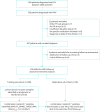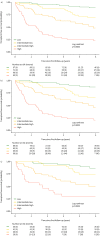Residual risk identified in routine noninvasive follow-up assessments in pulmonary arterial hypertension
- PMID: 37260464
- PMCID: PMC10227628
- DOI: 10.1183/23120541.00072-2023
Residual risk identified in routine noninvasive follow-up assessments in pulmonary arterial hypertension
Abstract
Background: The 2022 ESC/ERS guidelines on pulmonary hypertension recommend noninvasive risk assessments based on three clinical variables during follow-up in patients with pulmonary arterial hypertension (PAH). We set out to test whether residual risk can be captured from routinely measured noninvasive clinical variables during follow-up in PAH.
Methods: We retrospectively studied 298 incident PAH patients from a German pulmonary hypertension centre who underwent routine noninvasive follow-up assessments including exercise testing, echocardiography, electrocardiography, pulmonary function testing and biochemistry. To select variables, we used least absolute shrinkage and selection operator (LASSO)-regularised Cox regression models. Outcome was defined as mortality or lung transplant after first follow-up assessment.
Results: 12 noninvasive variables that were associated with outcomes in a training sub-cohort (n=208) after correction for multiple testing entered LASSO modelling. A model combining seven variables discriminated 1-year (area under the curve (AUC) 0.83, 95% confidence interval (CI) 0.68-0.99, p=8.4×10-6) and 3-year (AUC 0.81, 95% CI 0.70-0.92, p=2.9×10-8) outcome status in a replication sub-cohort (n=90). The model's discriminatory ability was comparable to that of the guideline approach in the replication sub-cohort. From the individual model components, World Health Organization functional class, 6-min walking distance and the tricuspid annular plane systolic excursion to systolic pulmonary arterial pressure (TAPSE/sPAP) ratio were sensitive to treatment initiation. Addition of TAPSE/sPAP ratio to the guideline approach numerically increased its ability to discriminate outcome status.
Conclusion: Our real-world data suggest that residual risk can be captured by noninvasive clinical procedures during routine follow-up assessments in patients with PAH and highlights the potential use of echocardiographic imaging to refine risk assessment.
Copyright ©The authors 2023.
Conflict of interest statement
Conflict of interest: No financial conflict of interest has arisen from any author that interferes with the study design, methods or results.
Figures





Similar articles
-
Interest of TAPSE/sPAP ratio for noninvasive pulmonary arterial hypertension risk assessment.J Heart Lung Transplant. 2022 Dec;41(12):1761-1772. doi: 10.1016/j.healun.2022.09.005. Epub 2022 Sep 14. J Heart Lung Transplant. 2022. PMID: 36202691
-
The role of the TAPSE/sPAP ratio as a predictor of mortality in Pulmonary Arterial Hypertension: Its value for patient risk stratification.JHLT Open. 2024 Oct 19;7:100168. doi: 10.1016/j.jhlto.2024.100168. eCollection 2025 Feb. JHLT Open. 2024. PMID: 40144836 Free PMC article.
-
The prognostic role of the echocardiographic tricuspid annular plane systolic excursion/systolic pulmonary arterial pressure (TAPSE/sPAP) ratio and its relationship with NT-proANP plasma level in systemic sclerosis.Front Cardiovasc Med. 2023 Jan 17;9:1021048. doi: 10.3389/fcvm.2022.1021048. eCollection 2022. Front Cardiovasc Med. 2023. PMID: 36733829 Free PMC article.
-
The role of TAPSE/sPAP ratio in predicting pulmonary hypertension and mortality in the systemic sclerosis EUSTAR cohort.Autoimmun Rev. 2023 Apr;22(4):103290. doi: 10.1016/j.autrev.2023.103290. Epub 2023 Feb 4. Autoimmun Rev. 2023. PMID: 36746368 Review.
-
Influence of Iron Deficiency on Clinical and Haemodynamic Parameters in Pulmonary Arterial Hypertension Cohorts.Heart Lung Circ. 2022 Dec;31(12):1594-1603. doi: 10.1016/j.hlc.2022.09.001. Epub 2022 Nov 16. Heart Lung Circ. 2022. PMID: 36402703 Review.
Cited by
-
Right ventricular strain to systolic pulmonary artery pressure ratio in response to treatment of pulmonary arterial hypertension.ERJ Open Res. 2024 Jul 8;10(4):00985-2023. doi: 10.1183/23120541.00985-2023. eCollection 2024 Jul. ERJ Open Res. 2024. PMID: 38978554 Free PMC article.
-
Management of pulmonary arterial hypertension:before, during and after pregnancy.Int J Cardiol Cardiovasc Risk Prev. 2024 Mar 17;21:200252. doi: 10.1016/j.ijcrp.2024.200252. eCollection 2024 Jun. Int J Cardiol Cardiovasc Risk Prev. 2024. PMID: 38549736 Free PMC article. Review.
References
LinkOut - more resources
Full Text Sources
